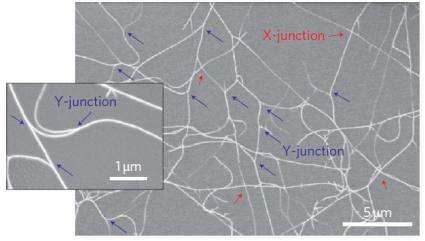February 16, 2011 feature
Carbon nanotube transistors could lead to inexpensive, flexible electronics

(PhysOrg.com) -- Recently, researchers have been developing carbon nanotube-based thin-film transistors (TFTs) in the hopes of creating high-performance, flexible, transparent devices, such as e-paper and RFID tags. However, one of the biggest challenges holding back the transistors’ performance is a trade-off between the properties of metallic and semiconducting nanotubes that make up the transistors. In a new study, researchers have developed a new way of fabricating nanotube networks that partly overcomes this problem, and show that the nanotube networks could be used to make transistors as well as flexible integrated circuits (ICs).
The researchers, Dong-ming Sun from Nagoya University in Nagoya, Japan, and coauthors from there and Aalto University in Finland, have published their study on the fabrication of high-performance TFTs and ICs on flexible, transparent substrates in a recent issue of Nature Nanotechnology.
“We have shown that, without consideration of carbon nanotube chirality, the as-grown carbon nanotubes can be used to fabricate high-performance TFTs and ICs, leading to a simple and fast technique for low-cost, flexible electronics,” coauthor Yutaka Ohno of Nagoya University told PhysOrg.com. “Lightweight and flexible devices such as mobile phones and electronic paper are gaining attention for their roles in achieving a smarter and green ubiquitous information society. It is important to manufacture such devices at extremely low cost in replacing conventional paper-based media such as newspapers and magazines. Our work can provide such technology.”
As the researchers explained in their study, nanotube networks contain both metallic and semiconducting nanotubes. While a greater amount of metallic nanotubes increases the transistor’s charge-carrier mobility, it also decreases the on/off ratio.
Since both of these characteristics are important for overall transistor performance, the researchers in the new study found a way to optimize both characteristics by fabricating a nanotube network with certain unique properties. For instance, the network’s morphology consists of straight, relatively long (10 micrometers) nanotubes (30% of which are metallic) compared to other nanotube networks. The new network also uses more Y-junctions than X-junctions between nanotubes. Since Y-junctions have a larger junction area than X-junctions, they also have lower junction resistance.

Using this nanotube network, the researchers fabricated TFTs that simultaneously demonstrate a high charge-carrier mobility and on/off ratio, offering significantly better performance than previous nanotube-based transistors. The researchers explained that the high mobility is due to the nanotube network’s unique morphology, while the high on/off ratio can be attributed to the lower density of metallic nanotubes, which can be controlled during the fabrication process.
After building the transistors, the researchers fabricated an IC capable of sequential logic – the first such circuit based on carbon nanotube transistors to date. In sequential logic circuits, the output depends on both the present input as well as the history of the input, so that these circuits have storage or memory functions.
The researchers predict that, by scaling up the fabrication process and using improved printing techniques, these nanotube-based TFTs could lead to the development of large-scale, inexpensive, and flexible electronics.
“Our near-future plan is to demonstrate roll-to-roll fabrication of CNT-based TFT arrays and ICs,” Ohno said. “To do so, we need to replace all the lithographic techniques by high-throughput printing techniques. For commercialization, we have to improve the uniformity of TFT characteristics more, but we are aiming at commercializing within five years.”
More information: Dong-ming Sun, et al. “Flexible high-performance carbon nanotube integrated circuits.” Nature Nanotechnology. Advance Online Publication. DOI: 10.1038/NNANO.2011.1
Copyright 2010 PhysOrg.com.
All rights reserved. This material may not be published, broadcast, rewritten or redistributed in whole or part without the express written permission of PhysOrg.com.


















